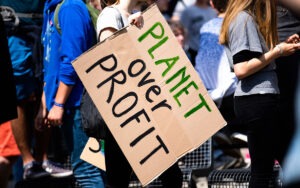
As the impacts of climate change become more severe and pervasive, young people and environmental groups are increasingly turning to the courts as a means of indicting governments and corporations for their role in exacerbating the problem. Legal action is not a new tactic for environmentalists. For decades, activists have used the courts to challenge polluting industries and push for stronger environmental regulations. However, what is new is the growing focus on climate change and the youth-led innovative legal strategies that are tailored to the unique challenges of tackling this global crisis.
One young person turning to legal action is 14-year-old Brianna K. (also known as Kū). Kū has heard of, but never seen, the once thriving wildlife along the shores of west Maui, HI, where she lives with her family.
Her elders recount tales of the rich and diverse ecosystems lost over time due to climate change. “We used to see so many different types of seaweed and fish in the same places where you swim now,” Kū’s grandfather tells her. They have also seen that in recent years, the weather in Maui has become unpredictable and has affected much of the family’s crops and ecosystems they depend upon.
Seeing Hawaii’s natural landscape change due to increased tourism and emissions prompted Ku and 13 other young people to take action against the Hawaiian government, which they believe has helped exacerbate climate change in the state. The young people allege that Hawaii violated their constitutional rights by failing to reduce greenhouse gas emissions from the transportation sector. Filed in June 2022, the lawsuit’s main objective is to compel the Department of Transportation to fully decarbonize by 2045. With the backing of US public interest law firms Our Children’s Trust and Earthjustice, the young Hawaiian plaintiffs are determined to fight for a better future for their community.
The Rise in Climate Change Lawsuits
According to a report by the Grantham Research Institute on Climate Change, the number of climate change-related cases worldwide has more than doubled since 2015, capping an exponential rise in such litigation over the past several decades. Roughly 800 such lawsuits were filed between 1986 and 2014—a period of nearly 30 years. From 2014 to mid-2022, over 1,200 climate change-related lawsuits were filed in just eight years. These lawsuits are being used as a new form of accountability as they challenge policies, carbon targets and call out polluting industries’ practices of spreading misinformation and delaying emissions reduction.
According to a report by the Grantham Research Institute on Climate Change, the number of climate change-related cases worldwide has more than doubled since 2015.
Climate change-related lawsuits tend to take two main approaches. The first focuses on constitutional and human rights arguments. For example, in the widely publicized 2015 ongoing case Juliana v. United States , plaintiffs sued the US government for violating their constitutional rights to life, liberty, and property by not taking sufficient action to combat climate change, thereby endangering their future. The case was brought by a group of young people led by climate activist Kelsey Juliana, who sought to compel the federal government to take more decisive action on climate change.
Both Juliana and the lawsuit brought by the young Hawaiian plaintiffs are part of a broader global movement of youth-led climate activism that has arisen in recent years. Youth-led lawsuits have been filed in several other countries, including Canada, Germany, and Norway.
While the Juliana case focuses on the future harm that climate change will cause, the young Hawaiian plaintiffs argue that they have already experienced harm to their culture and livelihood as a result of Hawaii’s carbon emissions. They also assert that the right to a clean and healthy environment is enshrined in the Hawaiian Constitution—which the government has failed to protect.
Similar constitutional arguments have been made in other lawsuits worldwide, including the landmark Urgenda Climate Case in the Netherlands, where a court ruled in 2019 that the government had a legal obligation to cut greenhouse gas emissions by at least 25 percent by 2020.
The second approach uses tort law to sue polluters for the damages they have caused. In the United States, several cities and counties have filed lawsuits against fossil fuel companies, arguing that they should be held liable for the costs of adapting to the impacts of climate change, such as rising sea levels and more frequent extreme weather events. The lawsuits, some of which are ongoing, seek billions of dollars in damages.
Karen Sokol, a professor of climate law at Loyola University New Orleans, called the suits “particularly distinctive worldwide, in that they’re the only ones, so far, that are seeking to hold the industry to account for its organized, systematic climate disinformation campaign.” These disinformation campaigns have outrightly denied the harmful effects that their industries cause to the environment and communities around them.
Sign up for our free newsletters
Subscribe to NPQ's newsletters to have our top stories delivered directly to your inbox.
By signing up, you agree to our privacy policy and terms of use, and to receive messages from NPQ and our partners.
“These companies knew for decades that greenhouse gas pollution from their operations and their products were having a significant and detrimental impact on the Earth’s climate,” said Peter F. Kilmartin, Rhode Island’s attorney general, announcing his state’s suit against companies like ExxonMobil, Chevron, BP, and Royal Dutch Shell. “Instead of working to reduce that harm, these companies chose to conceal the dangers, undermine public support for greenhouse gas regulation, and engage in massive campaigns to promote the ever-increasing use of their products and ever-increasing revenues in their pockets. It’s only fitting that they get sued for their misconducts.”
Using Litigation to Protect Indigeneity
The young Hawaiian plaintiffs’ recent lawsuit against Hawaii’s Department of Transportation is one example of cases being used as a tool to preserve Indigenous wellbeing. Thousands of kilometers away, the Torres Strait Islanders are already well into their own legal battle.
The Torres Strait Islands are a group of 274 small islands between Australia and New Guinea and are home to diverse Indigenous groups with unique cultures, languages, and identities. Unfortunately, they are also some of the most vulnerable places on the planet to the effects of climate change. Rising sea levels are already causing havoc; Torres Strait Regional Authority data show a yearly increase of six millimeters—twice the global average. For these Islanders, the fight against climate change is a fight for survival.
Over several years, Torres Strait Islanders have actively rallied against the looming dangers of climate change. They have enacted a steadfast, three-year campaign to prosecute Australia at the United Nations for breaching the fundamental rights of Torres Strait Islanders to culture and life. The crux of the claim was that Australia’s failure to effectively curtail national carbon emissions directly jeopardizes the existence of their communities. In a momentous victory for the Islanders, the UN Human Rights Committee validated their struggle and demanded compensation.
Two individuals from Torres Strait Island, Guy Paul Kabai and Pabai Pabai, filed a 2021 lawsuit to hold the Australian government accountable for failing to fulfill its legal obligation in preventing coastal erosion, one of the most significant climate impacts affecting the islands.
Their case sheds light on the additional adversities faced by Torres Strait Islander communities, including soaring average temperatures, intensifying heat waves, and more severe storm surges. Their case also illustrates how the influx of saltwater compromises the freshwater ecosystem on land while warming and acidification impact marine life through coral bleaching and food chain disruption.
Kabai and Pabai leave no room for ambiguity when it comes to their description of climate change as an injurious threat to their communities. “For over 65,000 years, our ancestors have inhabited these islands,” asserts Kabai. “If our homes are taken away from us, we will lose our very identity. As custodians of our land, it is our moral obligation to ensure that our communities, culture, and spirituality remain protected from the ravages of climate change.”
By showing that the legal system can be an effective tool for addressing climate change, [climate change-related lawsuits] help to build momentum, create a sense of urgency around the issue, and spark innovative climate policy.
Legal Victories
There have been some significant victories in recent years for climate activists. In addition to the Urgenda case in the Netherlands, courts in several countries, including Colombia, Pakistan, and the United States, have recognized the constitutional right to a healthy environment and ordered governments to take more decisive action on climate change.
For example, in the United States, several high-profile climate lawsuits have also successfully held fossil fuel companies accountable for their role in contributing to climate change. In 2017, ExxonMobil was ordered to pay a $2.5 million civil penalty for air pollution violations and pledge to spend $300 million on pollution-control technology at several plants along the Gulf Coast. And in 2021, a Dutch court ordered Shell to cut its greenhouse gas emissions by 45 percent by 2030.
These legal victories are important for the specific outcomes they achieve and the broader message they send. By showing that the legal system can be an effective tool for addressing climate change, they help to build momentum, create a sense of urgency around the issue, and spark innovative climate policy. For example, the Juliana case and other youth-led legal challenges have helped to shift the political debate around climate change, putting pressure on policymakers to take the issue more seriously. This helped to lead to legislation like the Green New Deal—crafted in response to the growing youth-led climate movement.
Communities worldwide see that they can exercise their legal rights to demand the change they deserve. These lawsuits are making it easier to connect the dots between the activities causing climate change and the slow movement of government to reduce and regulate it. They show that legal action can be an effective means of achieving change by providing a mechanism for accountability and justice for communities that have been disproportionately and historically harmed by climate impacts.











